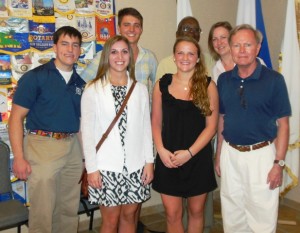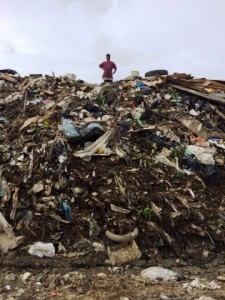What does a community in a developing country do with high volumes of trash and nowhere to put it? Possibly use it as an alternative fuel source.
Over the winter break, a student-faculty team traveled to Roatan Island, Honduras, to explore the feasibility of waste-to-energy power plants as an alternative to imported diesel fuel.

Courtney Landolfe ’14, Max Dixon ’16, and Corey McKenna ’16 at West End Roatan in Honduras
The study was part of the College’s Economic Empowerment & Global Learning Project, which takes a multidisciplinary approach toward community redevelopment initiatives. Teams of students and faculty from every academic division work hand in hand with residents to tackle economic issues locally, nationally, and internationally.
Roatan Island faces a challenge common in many developing Caribbean countries—lots of trash, nowhere to dispose of it, and no natural resources, making them dependent on imported diesel fuel for electrical generation. A waste-to-energy plant essentially burns trash instead of diesel fuel to create steam that turns a turbine to generate electricity. The team used Roatan Island as a case study last semester when it studied waste-to-energy power plants.
David Veshosky, associate professor of civil and environmental engineering, and Mary Wilford-Hunt, director of facilities planning and construction, led the student team: chemical engineering major Maxwell Dixon ’16 (Fair Haven, N.J.), economics and Spanish double major Courtney Landolfe ’14 (Chatham, N.J.), mechanical engineering major Corey McKenna ’16 (Saratoga Springs, N.Y.), and engineering studies major Arin Stasco ’14 (Garden City, N.Y.).

Max Dixon ’16, l-r, Courtney Landolfe ’14, Corey McKenna ’16, Arin Stasco ’14, Mary Wilford-Hunt, director of facilities planning, and David Veshosky, associate professor of civil and environmental engineering, presented their findings to members of the Roatan Rotary Club.
“We hope to contribute to knowledge about generating economic benefits from waste,” explains Veshosky. “The main problem facing implementation of waste-to-energy plants, besides the cost, is the volume of trash needed to make a plant feasible, limiting them to cities of one million or more, of which there are few in the Caribbean. If waste-to-energy plants could be made feasible for smaller communities, there would be many more potential applications.”
Before traveling to Roatan Island, Stasco used documents published by the World Bank, Environmental Protection Agency, and other institutions to estimate the trash produced in Roatan as well as a breakdown of the composition. Landolfe researched available case studies on waste-to-energy technology in areas of the world similar to Roatan so the team could narrow down models that would work for the community.
The trip to Honduras was critical for the project, say Stasco and Landolfe, because it allowed the team to collect real data by visiting the landfill, recycling center, and power company. The team presented their findings to the local Rotary Club and met with members to gain more information to refine their models.

A student stands atop a huge garbage pile.
“There is high value in studying real-world problems,” says Stasco. “When applying what you learn in the classroom to applicable scenarios, you can really expand what you know, especially when working closely with local residents.”
The waste-to-energy project grew out of a previous project in Honduras funded by the National Science Foundation. Last summer, a team of six students spent six weeks in Yoro Province designing and supervising construction of storm water drainage improvements for a soccer field used by a league of teams from local villages. The field often floods during the rainy season, negatively impacting the local economy that depends on vendors selling food, drink, and wares at the games. The students finished their project early and took a brief vacation at Roatan Island.
A grant from Lafayette trustee Linda Assante Carrasco ’90 funded the Roatan Island project.



1 Comment
I have engineered and installed waste energy plants in addition to conventional power and coal gasification plants and am still consulting in this area…..would be interested in any written reports of your findings
Tks/Bob Quig ’60
Comments are closed.